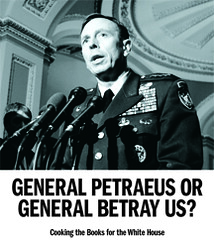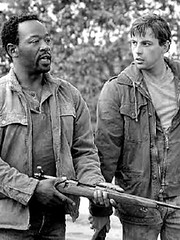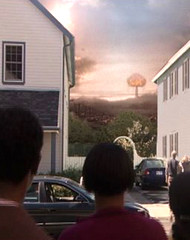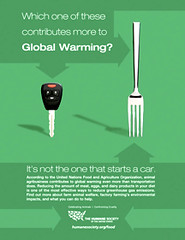On August 31, we announced the winners of an unofficial Expanded Universe Short Story Competition fan fiction contest to promote Jericho for the fans, expand its universe (outside of the town where it largely takes place on television), and demonstrate the possibilities of its rich story line. Today, we’re proud to present the work of Myles McNutt, who also writes about television on his blog Cultural Learnings. We hope you enjoy the story that takes the show's universe far forward. And congratulations to Myles McNutt!Dear Journal by Myles McNuttDear Journal,
People tend to exaggerate things when they talk in the post-bomb era. They don't have statistics or facts; it is commonplace to hear people throwing around statements like "everyone's lives are more difficult because of the bombs."
I stand an exception to this statement, a constant reminder that blanket statements are still a faux pas, even in our new nation. In all honesty, my life was easier in the wake of the attacks. Business was better than ever, in fact.
A world traumatized with fear is a psychiatrist's dream come true.
I won't deny being opportunistic after the bombs dropped. Before I had always approached my job with the greatest of care, treating each patient with my utmost attention. However, I was lured in by the curvy temptress of “opportunity,” who provides a bright, bountiful, and selfish future in this time of great turmoil.
Hundreds of patients walked into my office suffering from fear and anxiety. Before, I had to dig deep to find the root of their issue. Now, I listened to their concerns, nodded my head, and informed them that I thought their problems stemmed from the bombs. It was always the bombs.
Off they would go with a prescription that might never be filled, thanks to the government’s tight control of the drug supplies. I sat back with my cheques and wondered whether I was being honest with myself.
It was when I sent poor Ms. Gillis back off into the streets of the Big Apple with her worthless prescription, knowing full well I did little to earn the $500 sitting in front me, that I heard a noise.
"Excuse me, Dr. Forest?"
The voice at the door startled me. Her silhouette was tall and curvy. I swallowed.
"That's my name," I said in the disinterested voice I didn't have before the bombs. "You here for an appointment? There's a long waiting list, I'm sure that my reception…"
"I've already spoken to your receptionist, she said you'd be free," the woman informed me as she stepped further into the room. Electricity being at a premium, the lighting is always dim. I could make out her long brown hair and business suit. She didn't look or sound as if she was damaged goods.
"Well, I guess I could see a patient during my lunch…"
"Actually," she interrupted again, "I'm not a patient. My name is Keri Thorne and I represent an agency doing work in the … relief effort. We were wondering if you would like to assist us with a project."
I was intrigued: I had heard of some psychiatrists going out with relief teams to deal with post-traumatic stress disorder, but I had never been approached.
"What kind of project? I have appointments booked for a month or so, but I can head out into the field at the end of…"
"Actually," Thorne said with a bit of an impatient tone, "We don't do field work."
"Oh. Well then…"
I was too perplexed to guess at just what she did, but too nervous to ask. She was standing dangerously close to my desk.
"We work with those individuals who are getting in the way of the relief effort, if you will."
I still didn't know what she was talking about, so I simply nodded and she continued.
"It has come to the point where communities that once fought one another are turning their eyes toward the government's actions or, as it may be, their inactions," she said. "And so, we need to keep them from becoming a problem."
"So, why do you need a psychiatrist?" I managed to spit, the question burning in my mind.
"We're having some troubles in rural areas and some of the radicals are becoming more difficult to deal with. They are fiercely led, and those that we are capturing are … anxious, if you will."
I could have sworn she winked at me when she said it.
"Um, so, what do you need me for? If you're working for the government, which I think you are, surely you have access to…"
"Oh yes, Dr. Forest, we have all the tools we need to keep the situation under control," she said. "We just need to make it seem more, you know … official. Having a doctor present would make all the difference in, well, closing their prying eyes."
I finally understood what they were asking. They wanted me to be the doctor who gave them permission to destroy the minds of the people fighting for their communities, their livelihood. I swallowed loudly, again, and I think she noticed.
"I'm sorry," I said slowly as a shiver came over my body, "But I won't be able to do it. I, well…"
"I'm disappointed, Dr. Forest. From what your receptionist said, you've been willing to take advantage of these people before. I figured that serving your country might be…"
"You call that serving your country?!"
I was shocked by my own outburst, but Thorne simply frowned and started walking toward the door.
"Dr. Forest, this conversation never happened. Someone else, someone luckier than yourself, will benefit from our new future," she said, walking out the door. I never saw her again.
The next day my medical license was revoked and I learned that my colleague a few streets down had resigned from his practice and headed west with the government. I lost my job and my livelihood in that moment. But I regained something greater — my conscience.
I write this from a refugee camp in the Midwest. In front of my tent, there is a line of people waiting for me to ease their fears and help their condition.
They are no longer cheques to me, but people. And my job, in the post-bomb era, is to make their lives easier.
Dr. John ForestDisclaimer: "Jericho and its related characters are the property of CBS Paramount Television Network and Junction Entertainment. This contest is solely for entertainment purposes. Neither Myles McNutt, Richard Becker, nor Copywrite, Ink. is affiliated with CBS or Junction Entertainment.


































